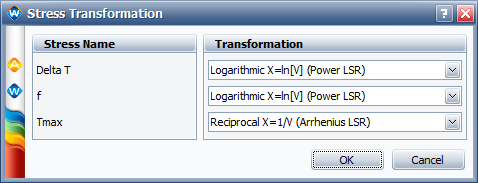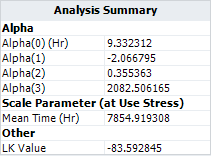|
|
| Line 67: |
Line 67: |
|
| |
|
| [[image:Norris-Landzberg Exp_Analysis Summary.png|center]] | | [[image:Norris-Landzberg Exp_Analysis Summary.png|center]] |
|
| |
|
| |
| The above results are close to what the book has.
| |
Revision as of 15:20, 13 June 2014
ALTA_Reference_Examples_Banner.png
This example compares the results for the Norris-Landzberg life-stress relationship. This can be accomplished in ALTA by using the general log-linear model (GLL) with proper stress transformations.
Reference Case
The data set is from Example 7.2 on page 257 in book Life Cycle Reliability Engineering by Dr. Guangbin Yang, John Wiley & Sons, 2007.
Data
The following table shows the thermal cycling profiles and test results for chip-scale package solder joints. In this example, the thermal cycling profile is represented by three independent stresses. These are: maximum temperature ([math]\displaystyle{ \,\!T_{Max} }[/math]), temperature difference ([math]\displaystyle{ \,\!\Delta T }[/math]) and cycling frequency ([math]\displaystyle{ \,\!f }[/math]).
| Failure Time
|
TMAX (°C)
|
Delta T (°C)
|
[math]\displaystyle{ \,\!f }[/math]
|
| 208 |
80 |
120 |
1
|
| 225 |
80 |
120 |
2
|
| 308 |
80 |
120 |
3
|
| 142 |
100 |
140 |
2
|
| 108 |
120 |
160 |
2
|
| 169 |
100 |
120 |
2
|
| 131 |
120 |
120 |
2
|
| 1300 |
80 |
50 |
2
|
| 650 |
100 |
70 |
2
|
| 258 |
120 |
90 |
2
|
| 6231 |
30 |
50 |
2
|
| 1450 |
30 |
70 |
2
|
Result
The book uses a multiple linear regression model to analyze the data set. The model parameters are estimated using the least squares method. The regression model is shown next:
- [math]\displaystyle{ \begin{align}\\
=&ln\left ( L \right )=\alpha _{0}+\alpha _{1}ln\left ( \Delta T \right )+\alpha _{3}ln\left ( \frac{1}{T_{MAX}} \right )\\
\\
=&9.517-2.0635\times ln\left ( \Delta T \right )+0.3452\times ln\left ( f \right )+2006.4\times \left ( \frac{1}{T_{MAX}} \right )
\end{align}\,\! }[/math]
Results in ALTA
In ALTA, we use the general log-linear life-stress relationship with the exponential distribution (GLL-exponential model). The following picture shows the proper transformation for each stress.
The following picture shows the results in ATLA. Note that ALTA uses maximum likelihood estimation to estimate the parameters; therefore, the results are close to, but not exactly the same, as the results given in the book, where the least squares method is used.

